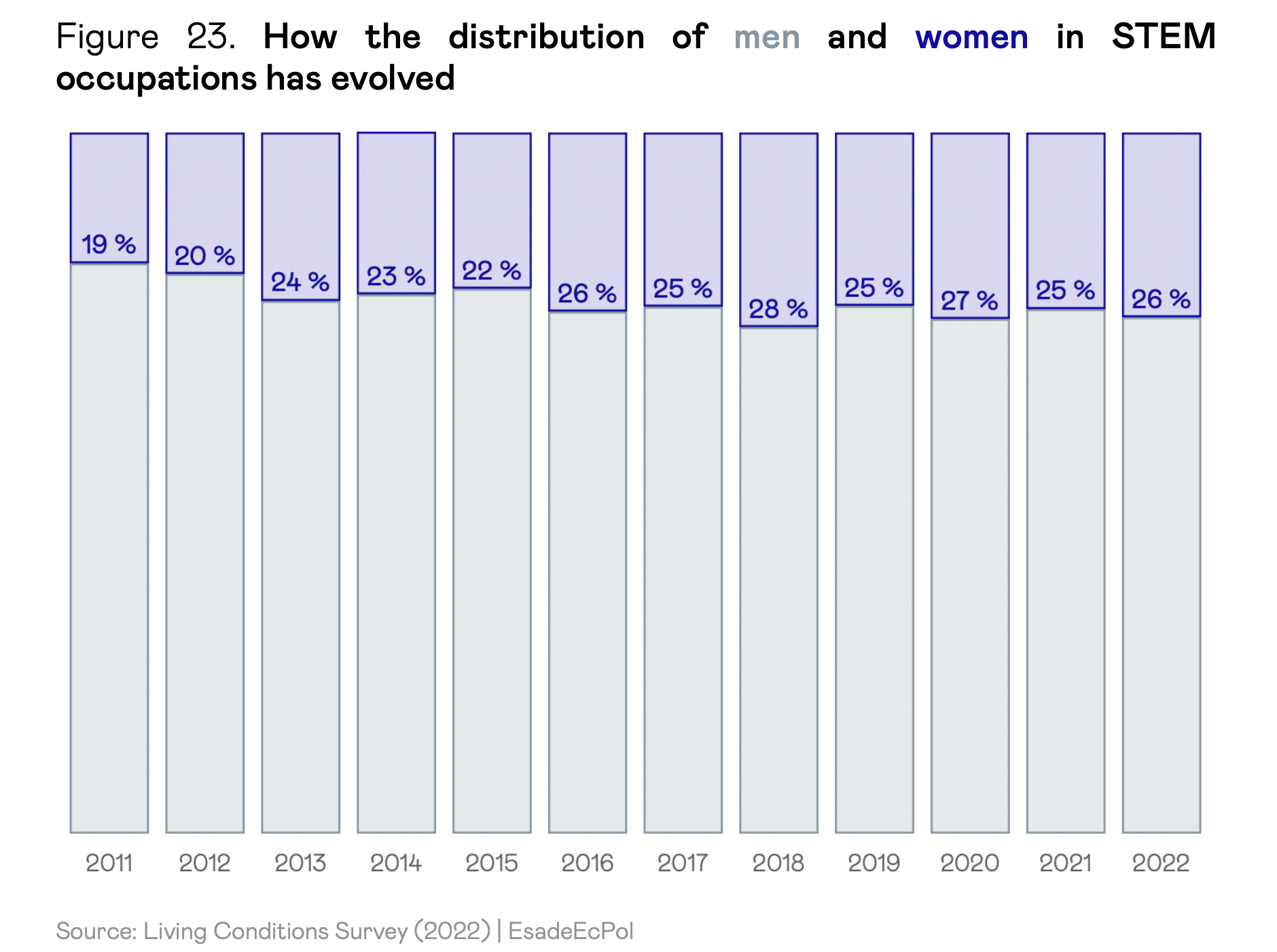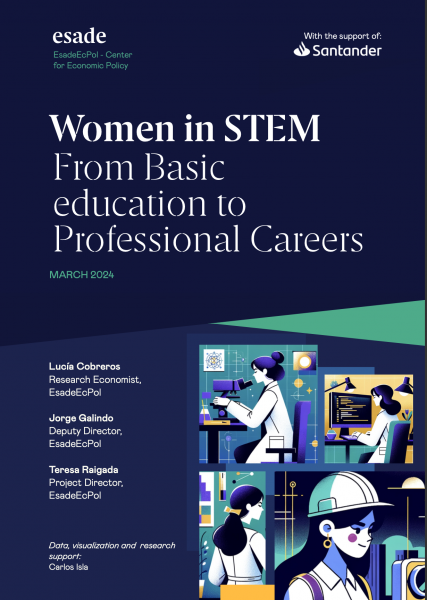
Women in STEM: From Basic Education to the Professional Career
Lucía Cobreros Vicente, Jorge Galindo, Teresa Raigada
4 Mar, 2024
This study proposes the most in-depth and detailed analysis of gender inequality in STEM fields in Spain to date. Distinctively, we focus on areas with a significant emphasis on mathematics, where the most pronounced gaps occur; we cover everything from basic education, thanks to the latest PISA results, to the professional career, for which we create new indicators. Moreover, we use unprecedented data combined with the highest quality economic evidence.
Basic Education
Differences in mathematics outcomes are evident from primary education. This is manifested in lower self-confidence, higher anxiety towards mathematics, and emotional impact on girls, leading to lower results.
Thanks to a thorough and unprecedented analysis of PISA 2022 data and previous editions, we observe that:
→ At 15 years old, the gap between boys and girls in math grades is significant, although it has decreased by 37.5% since 2012. The gap does not exist among students with the lowest grades, but it does in the rest.
→ The gap is significant in all mathematical content evaluated, being more pronounced in the ability to identify and formulate problems.
The accumulated evidence indicates that these differences in outcomes vary due to affection, self-perception, and anxiety towards mathematics.
→ Self-perception and affection: as early as the 4th grade, girls are 15% less likely than boys to consider mathematics their favorite subject, and between 8 and 9% less likely to consider themselves good at it, learn quickly, or enjoy it. They are more likely to think of it as boring and difficult, although they are more likely to dedicate time or effort to it. In contrast, they lose interest or are more likely to give up when they don’t understand the subject.
→ Anxiety: at 15 years old, girls are substantially more likely than boys (21%) to report feeling nervous or hopeless when solving mathematical problems, as well as worrying about low grades. Furthermore, these figures are worse in 2022 than they were a decade ago.
All these markers have a significant relationship with outcomes in mathematics: negative self-perception relates to lower results, while affection relates to higher ones.
Chosen Education: High School, University, and Vocational Training
Expectations translate into choices from the moment they are available to both girls and boys, as we observe by collecting, completing, and expanding the existing evidence:
→ In High School, the presence of girls in scientific-technical branches is consistently lower, despite the fact that the percentage who complete their studies successfully is higher than that of boys.
→ A similar situation occurs with university entrance exams, where girls less frequently choose subjects like Physics (x2,65) or Technical Drawing (x2,13), despite obtaining identical or slightly higher grades in the admission to the careers that require them.
→ The next step is that the rates of women in total enrollments in STEM university degrees do not reach 50% in almost any case, and in Mathematics (36%), Physics (27%), Telecommunications (23%), or Computer Science (13%) they are especially low.
→ Moreover, there has also been a decline in absolute terms: in Mathematics, it was 51% in 1990; 6,257 women, vs. 4,836 now. In Physics, 5,074 (31%) compared to 3,171. And in Computer Science, it reached 16,900 in 2000 (21%), not even reaching 5,000 in 2020.
→ The pattern repeats itself in postgraduate studies: 31% enrollment in Engineering and Construction master’s degrees, 25.5% in Mathematics and Statistics, and not even 23% in
Computer Science.
→ And in Vocational Training, the gap is even deeper: of all the men graduated in Vocational Training, 52% are in STEM fields; compared to only 7% of women. In most STEM degrees, both medium and higher levels, the men/women ratio is practically 9 to 1.
The Gender Gap in STEM Occupations
Data from early stages predict that the gaps will transfer to the professional career: the likelihood of aspiring at fifteen years old to have a STEM profession by 30 is 12,7% lower for girls than for boys, a gap that does not vary when taking performance level into account.
Thanks to the development of a novel indicator, we can calibrate the actual presence of women in STEM occupations:
→ The percentage of women in a STEM occupation out of the total employed women in Spain at the end of 2022 is 5,5%. For men, this figure reaches 13%, so the ratio is x2,4 in favor of men. The rate of women has increased substantially since 2011, when it was at 3.3%.
→ Among those under 30, women in STEM occupations reach 9%, reducing to 7% among those aged 30 to 44. The improvement since 2011 is also greater among the younger population.
→ If the total number of STEM positions is divided by gender, only 1 in 4 is occupied by a woman, a proportion that has remained constant since 2011.
→ By sector, STEM occupations have a lower female presence in construction (18%) and information and communications (23%).
All this suggests that the fact a woman is trained in these fields does not necessarily translate into being employed in them.
→ Our analysis indicates that women who have completed a STEM degree have, 5 years later, around a 2,7% lower probability of working in a STEM occupation than their male counterparts. This underrepresentation in STEM fields implies less access for women to what evidence indicates as better working conditions:
→ In Spain, women in professional or technical STEM occupations face a significantly smaller wage gap compared to the average, and notably less than their counterparts in non-STEM fields.
→ At the same time, women employed in a STEM field are less likely to end up with part-time employment.
Ideas and Proposals
Curricular rigidity, lack of pedagogical tools, and insufficient reinforcement, support, and guidance are structural problems in our educational system that deepen situations of initial disadvantage. Addressing these issues would benefit equal opportunities, including improving the participation of female students in STEM subjects:
→ Promote participation in STEM areas through courses, extracurricular or summer activities, while also activating mechanisms of self-confidence, self-perception, and affection towards mathematics.
→ Eliminate biases from the curriculum and materials, making them more flexible and adaptable to the needs of all students, achieving more inclusive educational models and content.
→ Provide teachers with teaching tools to deliver STEM education that minimizes biases, inclusive, more individualized, dynamic, with collaborative problem-solving in scientific-mathematical issues.
→ Offer individualized guidance to support decision-making and ensure that no one neglects a potential choice of pursuing STEM education due to a lack of adequate guidance at the right time.
Moreover, more specifically, we propose:
→ Raising awareness among families, increasing exposure to mathematical concepts at home from an early age, and promoting parental involvement in the learning process of mathematics.
→ Increasing girls’ access to role models at crucial decision-making times through mentorships, master classes, or other forms of direct access to women currently holding STEM positions.
→ Encouraging access to boot camps, intensive training programs to acquire specific skills in STEM.
In the workplace, we suggest:
→ Promoting an inclusive work environment, changing the perception of younger people about STEM occupations and reducing the dropout of women already in these careers.
→ Ensuring policies that support equal opportunity access to STEM careers, with co-responsible work-life balance for men and women, equitable remuneration and promotion, and well-specified rules.


Economista enfocada en educación, con interés en salud, género y competencia. Grado en Economía por la Universidad de Cantabria, Master en Economía Industrial y Mercados (UC3M).
View profile
Project Manager & Content Curator, EsadeEcPol. Licenciada en Economía y Derecho por la UC3M, Master en Administración Pública por la London School of Economics.
View profile

